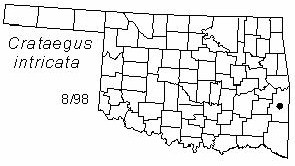Shrub or small tree to 8 m (25 ft) in height. Crown broad, irregular. Twigs red-brown to gray at maturity, glabrous; spines absent or few to many, 2.5-5 cm (1-2 in) long, red-brown to black. Leaves alternate, simple, elliptic-ovate, 2-7 cm (0.8-2.8 in) long, 1.3-5 cm (0.5-2 in) wide, glabrous, yellowish green in color; cuneate at base, acute at apex, margins singly or doubly serrate with gland-tipped teeth, 3-4 acute lobes present. Flowers in corymbs, glabrous, 3-7 in number, 0.8-1 cm (0.3-0.4 in) wide; petals 5, white; styles 3-4; stamens 10, exserted; flowers appear from April to May. Fruits pomes, 13 mm (0.5 in) or less, pyriform or ellipsoid; calyx lobes deciduous or reflexed, yellow-green; fruits mature in October.
Distribution: Oklahoma, Arkansas, and Missouri, east to Alabama, north to Michigan and Vermont. Uncommon in Oklahoma.
Habitat : rocky slopes and woodlands.
Comments: Crataegus is from the Greek meaning "flowering thorn"; intricata refers to the intricate branching pattern.
Wildlife benefits: In general, the fruits of hawthorn species are eaten by several species of birds. The dense branching pattern provides shelter and nesting habitat for several species of birds.
NWI status: none
Distribution in Oklahoma: 
BACK
NEXT
RETURN TO INDEX
Last update: 9/9/99
 Go to Oklahoma Biological Survey Home Page
Go to Oklahoma Biological Survey Home Page
 Disclaimer
Disclaimer